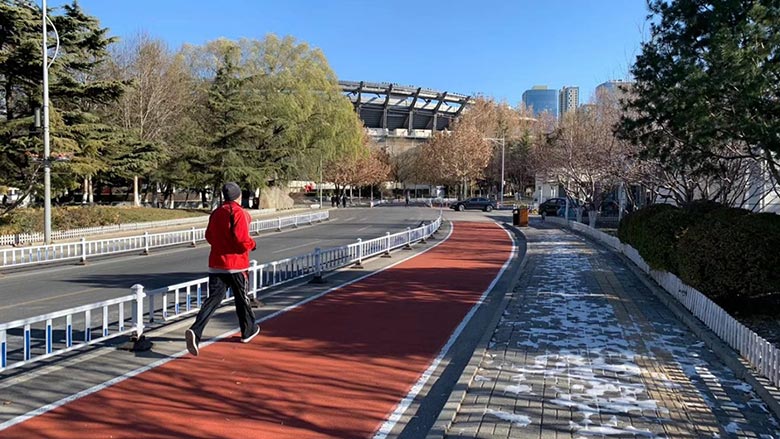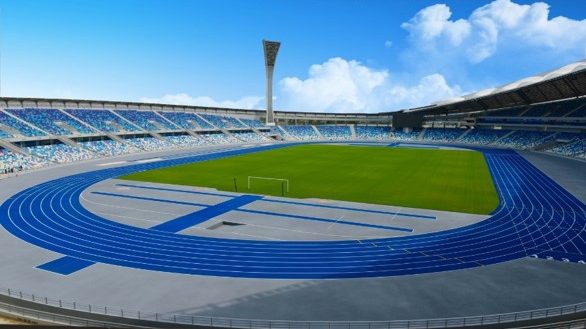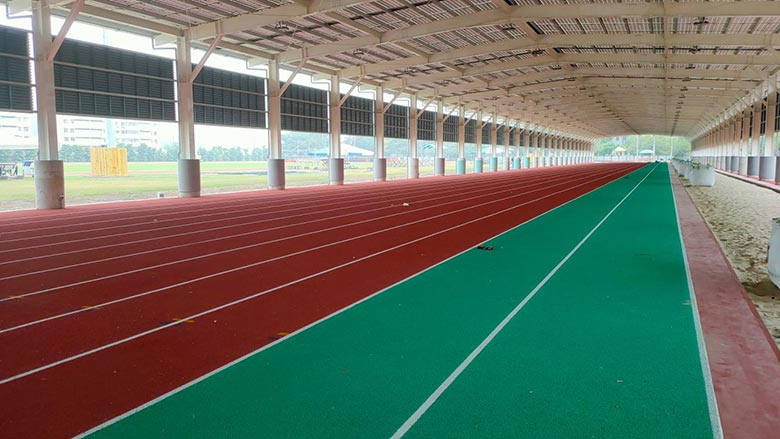How to Choose the Right Sports Flooring and Playground Surface Material

Motivated by an interest in weight loss, physical and mental health, and better cognitive functioning, Statistica estimates that 229.7 million Americans regularly engage in physical activity.1
At the same time, there is a risk of injury associated with sports and recreational activities. In fact, the U.S. National Security Council reports that 3,727,615 emergency room visits were caused by sports and recreational injuries from 2013 to 2020, with basketball, football, and playground equipment accounting for three of the top five top causes of injury. 2
While the circumstances of injury are varied, flooring surfaces are known to play a significant role. Of interest, Loughborough University’s Sports Technology Institute performed an extensive international study where 1,129 professional soccer athletes were surveyed. As reported in Sports Medicine, 91% of these players believed that the type or condition of the playing surface could increase their risk of injury.3

Flooring Selection
Taken together, selecting the right flooring material for a sports/recreation facility or playground is an important consideration.
When choosing a material, building owners and architects are encouraged to evaluate the following key factors and questions:
- Installation. What is involved in installing the flooring system. Will the manufacturer install the system or will the facility be responsible for the installation? Will the installation process cause off-gassing of harmful toxins? How soon will the flooring be ready for use after installation?
- Aesthetics. How important is aesthetics? How should the flooring look under different lighting conditions? To what extent should the flooring hide soiling?
- Maintenance. What level of maintenance will the flooring require? How much time and expense can the facility invest in maintaining the flooring? Will in-house staff be able to handle minor repairs or will the manufacturer need to be called in?
- Durability. How long will the surface last? What type of wear and tear will the system endure over time and to what extent can it be fixed? Will the planned facility use impact durability?
- Cost. Is the owner taking a longer-term, life cycle view of the cost? To what extent does installation and maintenance add to the purchase price?
- Safety. Does this floor meet the biomechanical needs of the athletes and users? Is there proper cushioning for impact? Is it too slippery or not slippery enough? Are there any protrusions that can cause a hazard?
- Performance. What are the performance standard levels for the facility? Was the flooring system designed for its intended use?
Key Performance Characteristics
When specifying flooring for sports facilities and playgrounds, it’s important to consider these systems in light of several important performance metrics. Depending on primary and secondary uses for the space, some performance characteristics will carry more weight in the evaluation process.
For example, for a running track, shock absorption and force reduction are important to help protect the runner’s joints. In a playground environment, endurance/durability and slip resistance are high priorities for the longevity of the play area and safety of the children.
A number of important performance characteristics are:
Rebound – measures how high a ball will bounce after impacting a floor’s surface. In measuring the rebound level of a basketball, a baseline comparison is made to concrete. Consequently, 100% rebound evaluates the surface providing the same level of rebound as concrete.
Though not an official test, one unique way to seek re-assurance that the flooring material will help athletic performance and lower risks of exercise-related injuries for children is the egg drop test. When dropped at a height of 1 m and 2 m, an egg will splatter on an EPDM floor. Conversely, when dropped on an expanded thermoplastic polyurethane surface, which incorporates an EPDM top layer and an eTPU sub layer, in both instances, the egg bounces as if it were a ball.
Shock absorption – measures the floor system’s ability to absorb impact forces generated by the user. The more the surface can absorb the impact, the less the user’s muscles and joints must absorb. As a frame of reference, concrete and asphalt provide little to no force reduction for a runner, athlete or child playing in the park. Consequently, they are not suitable materials for exercise and play areas.

Force reduction – is related to shock absorption and defined as the amount of force absorbed by the surface based upon the surface's ability to reduce impact forces. This provides a level of protection and safety for users.
While force reduction is important, it must be balanced with energy restitution which returns some energy to the athletic to keep the momentum going. In the absence of energy restitution, the athlete will feel like he/she is running in sand.
With higher energy restitution, the floor will be durable, which is more ideal for a weight room as the surface can better endure the impact of heavy weights hitting the floor be deflecting some of that energy. However, when the level of energy restitution is too high, the surface offers reduced cushioning, making it less ideal for playgrounds and increasing the risk of injury on sports fields.
Slip resistance – is measured by the coefficient of friction on a playground surface. The level of friction should be low enough to allow sliding when significant horizontal force is applied to the floor surface yet high enough to prevent uncontrollable sliding.
Tensile strength – determines a flooring system’s resistance to breaking under the tension stresses of being pulled apart.
The comprehensive strength – measures the surface’s breaking yield strength under compression.
The elongation at break – measures the elasticity, which is the amount of stretch contained in a material when taken to the point of breaking or tearing.
A floor material’s modulus of elasticity – is a calculated value based on the ratio of the breaking/flexural strength as compared to the deformation at break. This value is used to determine the relative rigidity and strength of the material.
Dimensional stability – measures a flooring surface’s ability to withstand temperature fluctuations without shrinking or cracking.
Impact resistance – measures the ability of a floor system to resist cracking, chipping or dis-bonding under an impact load.
Comparing Sports Flooring Materials
In selecting a sports flooring material, architects and owners, the more common options include wood, rubber, vinyl synthetic and plastic.
A classic choice, wood offers a traditional aesthetic, durability and a high level of bounce/rebound. On the flip side, the material requires a high level of maintenance. Because it expands and contracts with changes in temperature and humidity, and will incur damage when wet, it must be constantly ventilated. In addition, it lacks point-elastic, cushioning properties.
Ethylene Propylene Diene Monomer, commonly known as EPDM rubber, is a very durable, resilient and economical option. It can withstand heavy loads and high impact activity, and feels soft and comfortable underfoot. On the other hand, it becomes slippery when wet, emits a distinct odor and uses adhesives that are susceptible to fire.
Another low cost option is vinyl composition tile (VCT). To meet budgetary and multi-use needs, facilities may settle for VCT, but performance wise, there are drawbacks. The material does not provide cushioning, shock absorbency or much friction. This increases the risk of falls and joint injuries.

In comparing rubber to plastic foam, while rubber’s high shock absorption and anti-slip qualities make it suitable for gyms with weights and heavy training equipment, it is not ideal for courts and running tracks which require more bounce and a certain level of slippage to support agility and quick changes in direction. At the same time, plastic foam meets these needs and offers a mix of shock absorption and buoyancy. It also protects against fatigue, and is easy to clean and disinfect.
In the realm of plastic foam, a number of different materials are available. These include expanded polypropylene (EPP), ethylene-vinyl acetate (EVA), expanded polyethylene and thermoplastic polyurethane (TPU).
While the foam materials offer similar qualities, when taking a closer look, E-TPU – expanded thermoplastic polyurethane – stands out in the realm of endurance and tensile strength. For example, after 40,00 cycles where a dynamic load of 250kPa at 5 cycles per second is applied to a 40mm-thick EPE flooring product, it shrinks down to 9mm, which is just 22% of its original width. On the contrary, a 40mm-thick E-TPU sample emerges at 37mm, retaining 93% of its thickness after 40,00 testing cycles.
When tested to determine the point at which a plastic foam material will pull apart, a measure of the product’s tensile strength/elasticity, both EPS and EPP break at 30 kg/m3 whereas E-TPU holds its own up to 265 kg/m3.
The material also offers a higher rebound of 57% as compared to other plastics. In addition, as a closed-cell, elastic particle foam, E-TPU combines the properties of TPU with the advantages of foams, making it elastic as rubber but lighter.
Sustainability
As a plant-based bio TPU, thermoplastic polyurethane is a highly sustainable material. Fully based on methylene diphenyl diisocyanate, it does not require any solvent, phthalate, polycyclic aromatic hydrocarbon, chlorinated paraffin, heavy metal catalyst, or synthetic chemical referred to as MOCA.
A degradable, non-toxic and non-plasticizer, polyurethane lasts much longer than most thermoplastics. It can be melted and reused between product lifecycles and polyurethane waste can be used to generate power for solid waste incineration. What does end up going to waste is non-toxic and therefore won’t damage soil or water.
Regarding the product’s life cycle in the context of flooring, the factors of recyclability, low maintenance and longevity create a strong sustainability profile as compared to other flooring materials.
Guide to Sports Flooring Standards
The main organizational bodies with quality standards for sports flooring include:
- DIN Deutsches Institut fuer Normung EN. – This German industrial standard is the most widely used standard for sports surfaces.
- ISO International Organization for Standardization – Offers manufacturing and quality requirements for a variety of flooring surfaces falling under ISO 9000 or 9001 standards.
- World Athletics – To grant certification, the organization evaluates samples of actual, installed surfaces.
- ASTM International – The American Society for Testing and Materials develops international voluntary consensus standards.
Key sports flooring performance standards include:
- DIN EN ISO 845 specifies a method for determining the apparent overall density and the apparent core density.
- DIN EN ISO 846 specifies methods for determining the deterioration of plastics due to the action of fungi and bacteria and soil microorganisms.
- DIN EN ISO 1798 specifies a method for determining the strength and deformation properties of flexible cellular materials when a test piece is extended at a constant rate until it breaks
- DIN EN 1177 specifies a method for determining impact attenuation.
- ISO 844 specifies methods for determining the compressive strength and corresponding relative deformation, the compressive stress at 10% relative deformation, and the compressive modulus of rigid cellular plastics.
- DIN 53512 determines rebound resistance.
- DIN EN ISO 1836 specifies three methods for determining the compression set of flexible cellular materials.
- DIN ISO 2796 tests for dimensional stability in a range of temperature and humidity conditions.
- DIN EN 18035-7 establishes the environmental requirements of the soil and ground water for outdoor playgrounds and testing of bound elastic supporting layers, Elastic layers and synthetic turf layers
- ISO 8307 specifies a method for determining the resilience by ball rebound.
- ASTM F2772 specifies athletic performance properties for indoor sports flooring systems.
1 Lange, David. “Physical Activity – Statistics & Facts,” Mar. 16, 2021. https://www.statista.com/topics/1749/physical-activity/
2 Sports and Recreational Injuries, National Security Council. https://injuryfacts.nsc.org/home-and-community/safety-topics/sports-and-recreational-injuries/
3 Perceived Links Between Playing Surfaces and Injury: a Worldwide Study of Elite Association Football Players. Loughborough University, Loughborough, UK – Sports Technology Institute. Aug. 20, 2018. https://sportsmedicine-open.springeropen.com/articles/10.1186/s40798-018-0155-y
Looking for a reprint of this article?
From high-res PDFs to custom plaques, order your copy today!